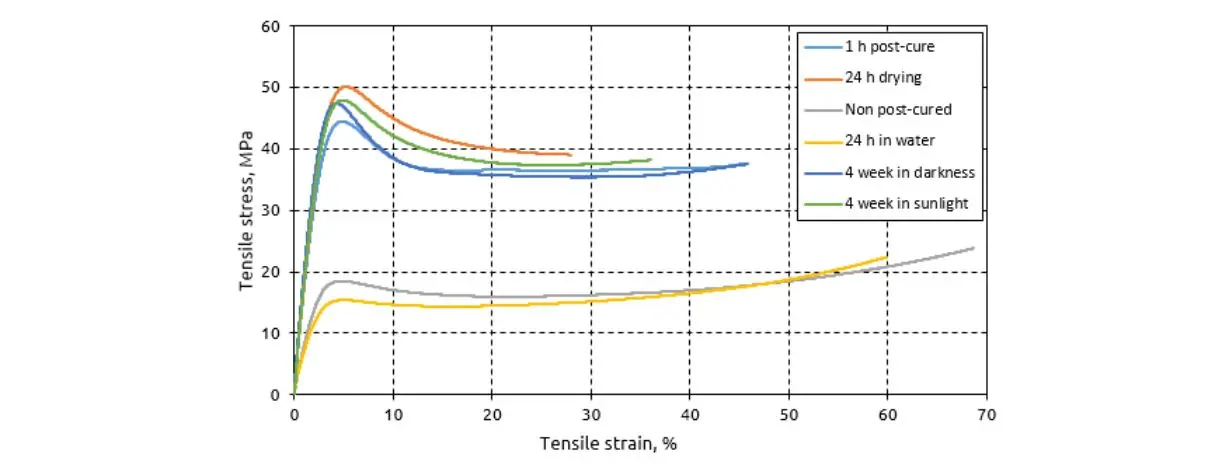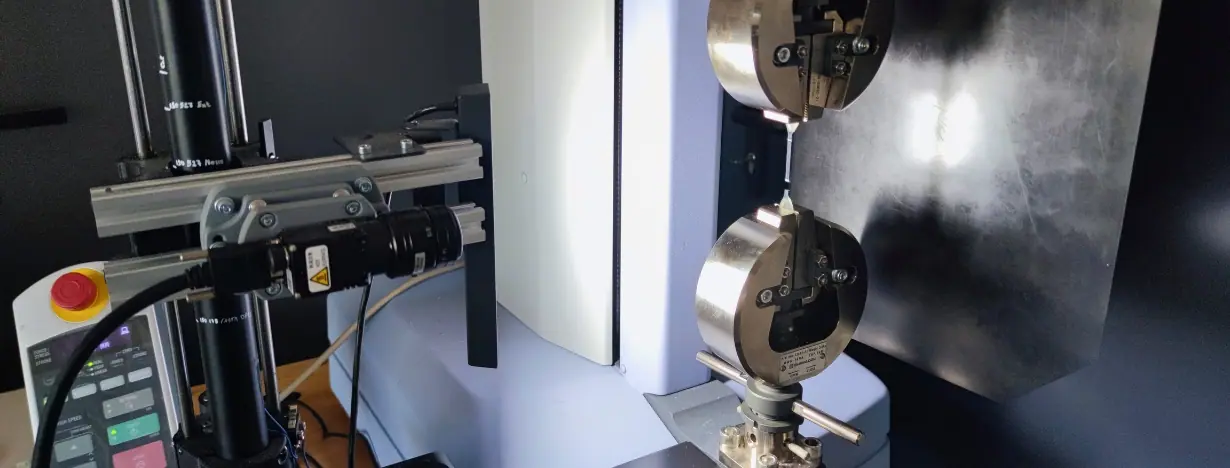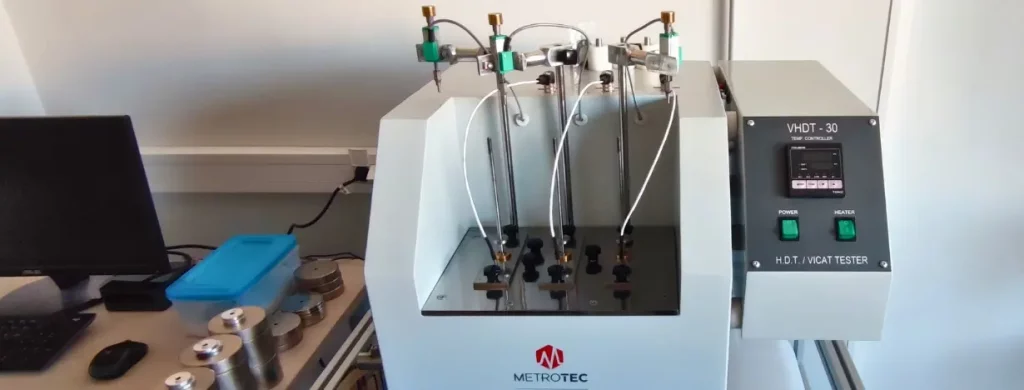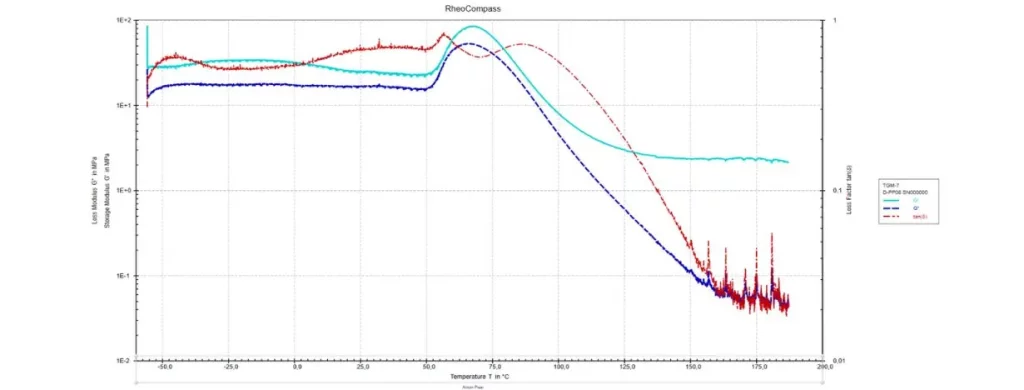The Ultimate 3D Printing Material Selection Guide
Introduction to Resin Mechanical Properties
When starting a 3D printing project, it is essential to understand resin mechanical properties to select the ideal material for achieving optimal performance, durability, and overall success of the final product. Specifically, resin—an integral component of additive manufacturing—offers various formulations, each with unique mechanical properties that impact the behavior of the printed object under different conditions. This guide will clarify the intricate aspects of resin’s mechanical properties. Moreover, it will address additional factors such as thermal conductivity and impact strength, offering a comprehensive overview of the critical characteristics you need to consider.
Understanding Variability in Resin Mechanical Properties

At AmeraLabs, we meticulously detail our testing process—including printing, washing, and post-curing—to ensure our data accurately reflects real-world performance. This approach provides a clearer understanding of how our resins perform in practical applications. While our methods are chosen for their simplicity and convenience, our primary goal is to deliver honest and reliable performance insights.
Furthermore, the National Institute of Standards and Technology (NIST) is leading efforts to standardize resin property testing, with AmeraLabs proudly participating. Recently, we engaged in a Working Curve Measurement (WCM) study aimed at establishing a uniform industry standard for resin performance evaluation. This initiative marks the beginning of measurement standardization, with additional standards expected in the future.
Although this blog post does not delve deeply into WCM—an intricate topic deserving its own article—it is crucial to note that WCM plays a vital role in resin 3D printing. Essentially, it helps determine optimal printing settings and exposure times, while also enabling effective comparisons of curing properties across different resins.
Key Resin Mechanical Properties and Their Implications
Understanding key resin mechanical properties is crucial for effective material selection. These properties, including tensile strain, flexural modulus, and flexural stress, are essential as they reveal how resins perform under varying conditions. Consequently, assessing these characteristics helps determine a resin’s flexibility, stiffness, and durability. Therefore, this knowledge guides you in choosing the best resin for your specific needs. By evaluating these critical properties, you can make informed decisions that ensure optimal performance and longevity of your printed parts.
Resin mechanical properties: Tensile Properties
Ultimate Tensile Strength
Ultimate tensile strength measures the maximum stress a resin can endure while stretching before breaking, which is crucial for evaluating material performance under tensile forces. Importantly, this parameter is often used to design components made from brittle materials, as these lack a yield point.

How It’s Measured
A tensile testing machine stretches a resin sample until it breaks while recording the maximum applied force.
Typical Ranges:
- Elastomers: 1-10 MPa
- Low: 10-20 MPa
- Medium: 20-40 MPa
- High: 40-60 MPa
- Very High: 60-100 MPa or more
Implications:
- High Tensile Strength: This signifies a stronger material capable of withstanding greater forces without breaking, making it ideal for high-load applications. For example, resins like AMD-3, with tensile strengths above 65 MPa, are excellent for structural components but may be brittle.
- Low Tensile Strength: On the other hand, combined with elongation before breaking, it indicates a more flexible material. Such resins are optimal for low-stress or non-load-bearing applications, as they absorb deformation without breaking.
- Application: When choosing resins for structural components, balancing tensile strength and flexibility is crucial. High-tensile strength resins like AMD-3 offer strength but may be brittle, while lower-tensile strength resins like XVN-50 provide flexibility. Thus, the best choice depends on balancing these properties to meet specific application needs effectively.

Tensile Strain at Break
Tensile strain at break is a mechanical property that measures how much a resin can stretch before breaking. It is expressed as a percentage. This property indicates the material’s flexibility and stretchability. Understanding tensile strain is crucial for choosing materials for mechanical deformation applications.
How it’s measured
During the tensile test, we measure sample elongation relative to its original length until it breaks. This elongation, expressed as a percentage of the original length, indicates the tensile strain at break.
- Typical Range:
- Very Low: 1-10%
- Low: 10-20%
- Medium: 20-30%
- High: 50-70% or more
- Elastomeric materials: 100-250%
- Implications:
- High Tensile Strain: Indicates greater flexibility and elongation before breaking, ideal for parts that need to bend or stretch without snapping. For example, TGM-7 offers an elongation at break of 61.6%, making it suitable for flexible tabletop gaming miniatures.
- Low tensile strain indicates less flexibility, thus making the resin less suitable for parts that need to withstand tensile forces.
- Application: Use high tensile strain resins for flexible parts, like miniature swords and spears, that need to withstand bending and stretching.

Tensile Modulus of Elasticity
The modulus of elasticity, also known as Young’s modulus, measures a resin’s stiffness or rigidity under tensile forces. It indicates how much the material will deform under stress within its elastic range, meaning before any permanent deformation occurs. In general, a higher modulus of elasticity means the resin is stiffer and resists deformation, therefore making it ideal for applications requiring shape stability, like structural components. On the other hand, a lower modulus indicates that the part could be easier to bend, which makes the resin less suitable for applications where high rigidity and low deformation are of utmost importance.
How it’s measured
We calculate the tensile modulus of elasticity from the stress-strain curve of a tensile test. This modulus reflects the material’s stiffness and comes from the slope of the curve’s linear portion, which indicates how well the material resists elastic deformation.
- Typical Range:
- Low: <1 GPa
- Medium: 1.5-2 GPa
- High: 2-4 GPa
- Very High: 4-8 GPa or more
- Implications:
- High Modulus: Indicates a stiffer material that resists bending and is suitable for load-bearing and structural applications. For instance, AMD-3 has a high modulus of elasticity, making it perfect for detailed statues and collectibles.
- Low Modulus: Indicates a more flexible material that bends easily and is less suitable for rigid parts.
- Application: Choose resins with a high modulus of elasticity for structural parts needing rigidity, such as frames and supports.
Resin mechanical properties: Flexural Properties
Flexural Modulus of Elasticity
The flexural modulus measures a resin’s stiffness under bending forces, reflecting its resistance to deformation. A higher modulus indicates greater stiffness and resistance to bending. It is more suitable for structural components such as beams or panels that require rigidity. Conversely, a lower modulus combined with high elongation at break signals greater flexibility, which is ideal for applications where bending without breaking is necessary, such as flexible seals or components. Understanding this property is crucial for selecting materials that balance rigidity and flexibility based on application needs.
How it’s measured
To measure the flexural modulus, place a resin sample on two supports and apply a central load. Then, derive the modulus from the load-deflection curve, which assesses the material’s stiffness and resistance to deformation under flexural stress.
- Typical Range:
- Low: 1-2 GPa
- Medium: 2-4 GPa
- High: 4-8 GPa or more
- Implications:
- High Flexural Modulus: Indicates a stiffer material that resists bending, making it ideal for structural applications. For example, XVN-50, with a modulus of 1.82 GPa, provides robustness for engineering needs.
- Low Flexural Modulus: Conversely, this suggests a more flexible material that bends easily, making it suitable for components requiring flexibility.
- Application: Choose resins with a high flexural modulus for components like beams and brackets that need to maintain shape under load. Alternatively, select resins with a lower modulus for applications where flexibility is essential.
Flexural Stress at Yield
Flexural Stress at Yield indicates when a resin starts to deform plastically under bending forces. Particularly, it marks the shift from elastic deformation, where the material returns to its original shape after removing stress, to plastic deformation, where changes become permanent. Once the resin reaches this yield point, it deforms irreversibly. It’s important to note that removing the stress will not make the resin return to its original form. Consequently, this measurement helps you gauge how well the material can handle bending forces without permanent damage.
How it’s measured
Determined by measuring the maximum stress the sample can withstand before it starts to permanently deform during the bending test.
- Typical Range:
- Low: 30-50 MPa
- Medium: 50-80 MPa
- High: 80-120 MPa or more
- Implications:
- High Flexural Stress: This indicates a resin capable of enduring higher stress without permanent deformation, thus making it ideal for high-load applications. Consequently, such resins are well-suited for components that must withstand significant forces without losing their shape.
- Low Flexural Stress: Conversely, this suggests a resin that deforms more easily under lower stress, which is suitable for applications where some permanent deformation is acceptable.
- Application: Choose resins with high flexural stress at yield for parts exposed to significant bending forces.
Flexural Strain at Yield
Flexural strain at yield measures how much a resin deforms before bending permanently under stress. It is expressed as a percentage.
How it’s measured
We measure it alongside flexural stress. This strain is calculated by observing the sample’s deflection at the point of yielding.
- Typical Range:
- Low: 2-5%
- Medium: 5-10%
- High: 10-15% or more
- Implications:
- High Flexural Strain: This signifies greater flexibility, enabling the material to bend before experiencing permanent deformation. Consequently, it is ideal for parts that need to flex without breaking, making it perfect for applications requiring enhanced adaptability.
- Low Flexural Strain: Conversely, this indicates reduced flexibility and is suitable for parts that must maintain their shape under bending stress. Thus, it is ideal for components that need to resist deformation and preserve their structural integrity under stress.
- Application: Therefore, choose resins with high flexural strain at yield for parts requiring flexibility and the ability to withstand bending without permanent deformation. In contrast, select resins with low flexural strain for applications where maintaining shape and structural stability is crucial.
Resin mechanical properties: Compression Properties
Compression Modulus of Elasticity
The compressive modulus measures a resin’s stiffness under compressive loads. It indicates how well the resin maintains its shape under pressure.
How it’s measured
We evaluate the compressive modulus by compressing the resin sample between two plates until it deforms. We calculate the modulus from the stress-strain relationship in the linear elastic region, which shows how well the material resists compressive forces.
- Typical Range:
- Low: 1-2 GPa
- Medium: 2-4 GPa
- High: 4-6 GPa or more
- Implications:
- High Compression Modulus: Indicates a material that resists compressive forces and maintains its shape, which is ideal for structural components.
- Low Compression Modulus: Unlike high compression modulus, low compression modulus indicates a material that compresses more easily and is suitable for cushioning or less critical structural applications.
- Application: Select resins with high compression modulus for components subjected to compressive forces, such as supports or load-bearing parts.
Additional Resin Mechanical Properties
Thermal Conductivity
Thermal conductivity measures how well a resin conducts heat, typically expressed in units like watts per meter-kelvin (W/m·K). It shows how quickly heat moves through the printed part when there’s a temperature difference. When a resin has high thermal conductivity, it efficiently transfers heat. This property makes it ideal for applications like heat sinks or electronic components where fast heat dissipation is crucial. On the other hand, low thermal conductivity means the resin acts as an insulator, which is perfect for thermal insulation, such as in insulating foams or protective coatings. Therefore, understanding thermal conductivity is vital when selecting the right material for effective heat management or insulation in various applications.
How it’s measured
Measure thermal conductivity using the heat flow meter or laser flash method. The heat flow meter assesses the rate of heat transfer through the material, while the laser flash method measures the time it takes for heat to pass through the sample after a pulse.
- Typical Range: 0.1 to 1.0 W/m·K
- Implications: Higher thermal conductivity is desirable for heat dissipation applications, while lower thermal conductivity may be suitable for insulation purposes.
- Application: Essential for parts exposed to high temperatures or requiring effective heat management, such as electronic housings or thermal barriers.
Dimensional Stability
Dimensional stability indicates how well a resin maintains its dimensions after printing and curing, consequently affecting the final accuracy and fit of the printed part. Often referred to as dimensional accuracy, this property is crucial for engineering applications.

How it’s measured
We measure changes in the sample’s dimensions before and after exposing it to environmental conditions like temperature fluctuations or humidity.
- Typical Range: Varies based on resin formulation and environmental conditions.
- Implications: Good dimensional stability ensures that printed parts retain their shape and dimensions, thus avoiding warping or shrinkage.
- Application: Important for precise engineering components and detailed models where exact dimensions are crucial.
Glass Transition Temperature (Tg)
Glass transition temperature (Tg) is the temperature at which a resin shifts from a rigid, glassy state to a more flexible, rubbery state, influencing its behavior at different temperatures.
How it’s measured
We determine the glass transition temperature (Tg) by using either differential scanning calorimetry (DSC) or dynamic mechanical analysis (DMA). DSC measures changes in heat flow as we heat the sample, while DMA tracks changes in mechanical properties across different temperatures.
- Typical Range: Generally 60°C to 150°C, with ESD-R-100 offering a higher Tg around 160°C.
- Implications: A higher Tg, like in ESD-R-100, allows the resin to maintain rigidity and structural integrity at higher temperatures, making it ideal for high-temperature applications such as soldering jigs.
- Application: Suitable for parts requiring thermal stability, especially in high-temperature environments.
Heat Deflection Temperature (HDT)
Heat deflection temperature (HDT) measures the temperature at which a resin deforms under a specific load. It’s an important property for applications where elevated temperatures are an issue. This indicates the material’s ability to maintain its shape and mechanical properties.

How it’s measured
We measure it by applying a specified load to a resin sample and gradually increasing the temperature until the sample deforms by a predetermined amount, typically 0.25 mm.

- Typical Range: 50°C to 300°C
- Implications: A higher HDT is desirable for applications requiring resistance to thermal deformation, while lower HDT may limit use in high-temperature environments.
- Application: Crucial for parts that experience continuous or intermittent heat exposure, such as engine components or electrical insulators.
Surface Resistivity
Surface resistivity measures how well a resin resists electrical conduction across its surface, which is important for electrical and electronic applications.

How it’s measured
Measured by applying a voltage across the sample’s surface and recording the resulting current, indicating how well the material resists electrical conduction.
- Typical Range: Usually between 10^7 to 10^15 ohms. For some advanced materials, like ESD-R-100, this is precisely controlled within a range of 10^7 to 10^10 ohms per square.
- Implications: A lower surface resistivity indicates that the resin is a good conductor and does not build up a charge on the surface, preventing electrical leakage or short-circuiting and providing effective electrostatic discharge (ESD) protection.
- Application: Essential for electronic components and applications where electrostatic discharge is detrimental.
Impact Resistance
Impact strength measures a resin’s ability to withstand sudden forces or shocks without breaking.
How it’s measured
Tested using methods like the Izod test. In the Izod test, a notched (or unnotched) sample is struck by a pendulum, and the energy absorbed before breaking is recorded.
- Typical Range: Typically measured in kJ/m².
- Implications: High impact strength indicates that the resin can absorb significant shocks or impacts without failing. Resins like TGM-7 have impressive impact resistance and are suitable for cases where
flexibility and impact resistance are top priorities. - Application: Important for parts exposed to high-impact forces, such as protective casings or tools.

Water Absorption
Water absorption measures the amount of water a resin can absorb, impacting its mechanical properties and dimensional stability. Resins with high water absorption can swell, degrade, or lose strength, which can be problematic in moisture-prone environments. Conversely, low water absorption indicates better resistance to these effects, making the resin suitable for outdoor applications, underwater parts, or environments with fluctuating humidity.
How it’s measured
We measure it by immersing a resin sample in water for a specified duration, then calculate the percentage increase in weight due to water uptake.
- Typical Range: 1% to 10%
- Implications: Lower water absorption is optimal for applications requiring dimensional stability and resistance to moisture-induced degradation.
- Application: Important for components exposed to moisture, such as marine parts, outdoor fixtures, or packaging materials.
Flammability
Flammability indicates how easily a resin ignites and burns, which is crucial for safety and compliance with fire regulations.
How it’s measured
We assess flammability by exposing the sample to flames or heat sources under controlled conditions and observing its ignition and burning behavior.
- Typical Range: Often measured according to standards such as UL94.
- Implications: Resins with lower flammability ratings are safer for applications where fire resistance is critical.
- Application: Essential for applications requiring compliance with fire safety standards, such as in electronics or aerospace components.
Fatigue Resistance
Fatigue resistance measures how well a resin can withstand cyclic loading or repeated stress without failing, important for parts subjected to continuous or repetitive forces.
How it’s measured
We measure it by applying cyclic loading to the sample in a fatigue testing machine until failure occurs, recording the number of cycles it withstands.
- Typical Range: Varies widely based on resin formulation and application.
- Implications: Higher fatigue resistance ensures that the resin can endure repeated stress cycles without cracking or failing.
- Application: Critical for parts used in mechanical systems or structures subjected to constant movement or load variations.
Environmental Resistance
Environmental resistance encompasses various aspects, including resistance to UV light, temperature fluctuations, and chemical exposure over time.
How it’s measured
We evaluate environmental resistance by exposing the resin sample to different conditions, such as UV light, moisture, or chemicals. We then measure changes in its physical and mechanical properties to assess its durability.
- Typical Range: Varies based on specific environmental factors.
- Implications: Good environmental resistance ensures that the resin maintains its properties and appearance under varying conditions.
- Application: Important for outdoor applications or parts exposed to harsh environmental conditions.
How to Decide Which Properties Matter the Most
Know What You Need
First, determine the part’s function. For instance, if you need a high-durability prototype, choose resins with high ultimate tensile strength and elongation at break. Consider the environmental factors and stresses the part will face as well. For miniatures or display models, resins that offer a balance of flexibility and impact resistance are often ideal.
Check the Key Properties for Your Project
If strength and load-bearing capacity are essential, focus on resins with high tensile and flexural properties to handle significant stresses. Conversely, if flexibility and durability are more important, choose resins that offer a balance of these traits, especially for parts that will experience regular movement or impact.
Consider Printing and Cleaning
Next, consider the resin’s viscosity. Lower-viscosity resins generally speaking are easier to print and wash, while higher-viscosity resins usually have better mechanical properties. Keep in mind that high viscosity resins are generally more difficult to print with. Also, ensure that the resin’s UV compatibility matches your printer for optimal curing and print quality.
Balance the Resin’s Mechanical Properties
Identify the essential features for your project and prioritize these when selecting a resin. Be mindful of potential trade-offs, such as between flexibility and hardness, to achieve the desired performance.
Test Your Choices
Finally, prototype testing is crucial. Print test parts with different resins to assess their performance under real conditions. This approach helps you make an informed decision, ensuring the success of your 3D printing project.
Key Takeaway: Identify the essential features for your project and prioritize these when selecting a resin. Balance the properties to achieve the desired performance and test your choices through prototypes.
Conclusion
Selecting the right resin for your 3D printing project can significantly impact the success and quality of your final product. By understanding resin mechanical properties, you make informed decisions aligned with your project needs. This guide covers key properties, including tensile strength, flexural modulus, thermal conductivity, and impact resistance. Each property plays a distinct role in performance. Often, the best choice involves balancing multiple factors to meet specific requirements. While this guide provides a comprehensive overview, it’s important to consider that resin technology is continually evolving. We encourage you to stay informed about the latest developments and to conduct your own tests when possible.
Don’t hesitate to contact us for expert advice and support in selecting the best resin for your needs. Happy printing!
Comparing the Mechanical Properties of AmeraLabs 3D Printing Resins
| Resin Mechanical Property | XVN-50 | TGM-7 | AMD-3 | DMD-21 | DMD-31 |
|---|---|---|---|---|---|
| Tensile Strain/Elongation at Break | 51.2 % | 61.6 % | 4 % | 2.6 % | 4 % |
| Flexural Modulus of Elasticity | 1.82 GPa | 1.54 GPa | 2.74 GPa | 3.16 GPa | 2.82 GPa |
| Flexural Stress at Yield | 43.4 MPa | 57.1 MPa | 83.6 MPa | 95.9 MPa | 108.8 MPa |
| Flexural Strain at Yield | 6.7 % | 6.2 % | 4 % | 3.8 % | – |
| Compression Modulus of Elasticity | 1.52 GPa | 1.59 GPa | 1.57 GPa | 1.82 GPa | 1.96 GPa |
| Viscosity | 560 mPa∙s | 540 mPa∙s | 390 mPa∙s | 370 mPa∙s | 670 mPa∙s |
| Hardness | 82 D | 78 D | 85 D | 79 D | 88 D |
| Impact Resistance (Notched) | 5.9 kJ∙m-2 | 8.22 kJ∙m-2 | 2.73 kJ∙m-2 | 0.96 kJ∙m-2 | 2.11 kJ∙m-2 |
| Density (Liquid) | 1.095 g∙cm-3 | 1.105 g∙cm-3 | 1.119 g∙cm-3 | 1.123 g∙cm-3 | 1.109 g∙cm-3 |
| Density (Solid) | 1.213 g∙cm-3 | 1.21 g∙cm-3 | 1.243 g∙cm-3 | 1.237 g∙cm-3 | 1.23 g∙cm-3 |
| Water Absorption (24 h) | 3.12 % | 7.96 % | 0.392 % | 0.392 % | 0.19 % |
| Critical Dose | 1.216 mJ∙cm-2 | 1.193 mJ∙cm-2 | 1.14 mJ∙cm-2 | 1.496 mJ∙cm-2 | 3.353 mJ∙cm-2 |
Glossary
| Term | Definition |
|---|---|
| Compression Modulus of Elasticity | Measures stiffness under compressive loads; crucial for structural support. |
| Dimensional Stability | Ability to maintain original dimensions despite environmental stressors like temperature and humidity. |
| Environmental Resistance | Durability against factors such as UV light, chemicals, and temperature variations. |
| Fatigue Resistance | Capacity to endure repeated stress cycles without failure. |
| Flexural Modulus of Elasticity | Indicates stiffness during bending. |
| Flexural Strain at Yield | Deformation extent at the yield point under bending stress. |
| Flexural Stress at Yield | Stress level at which permanent deformation begins under bending forces. |
| Flammability | Ease with which a material ignites and burns. |
| Glass Transition Temperature (Tg) | Temperature at which a material changes from rigid to flexible; key for polymers and plastics. |
| Heat Deflection Temperature (HDT) | Temperature at which a material begins to deform under load; indicates heat performance. |
| Impact Resistance | Ability to absorb impact energy without breaking; essential for protective gear and automotive parts. |
| Surface Resistivity | Resistance to electrical conduction across a material’s surface; important for insulation. |
| Tensile Modulus of Elasticity | Stiffness under tensile stress; crucial for structural and load-bearing components. |
| Tensile Strain at Break | Elongation percentage before breaking under tensile stress; indicates ductility. |
| Tensile Stress at Break | Maximum stress endured before breaking under tension; important for strength assessments. |
| Thermal Conductivity | Rate of heat transfer through a material; important for insulation and heat dissipation. |
| Water Absorption | Percentage weight increase due to water uptake; affects stability and mechanical properties. |

